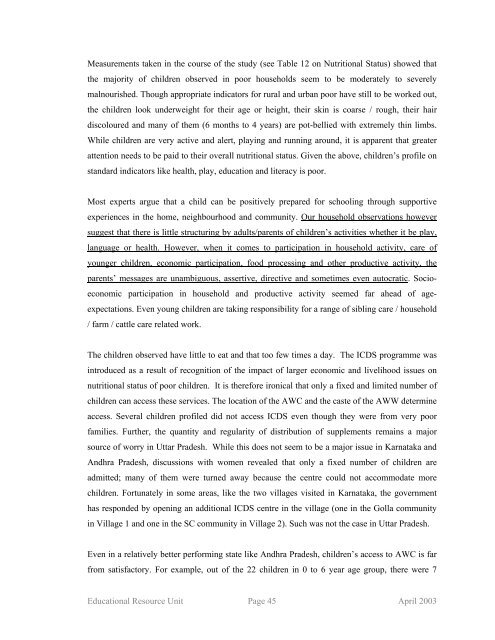Snakes and Ladders - ERU Consultants Pvt. Ltd.
Snakes and Ladders - ERU Consultants Pvt. Ltd.
Snakes and Ladders - ERU Consultants Pvt. Ltd.
You also want an ePaper? Increase the reach of your titles
YUMPU automatically turns print PDFs into web optimized ePapers that Google loves.
Measurements taken in the course of the study (see Table 12 on Nutritional Status) showed that<br />
the majority of children observed in poor households seem to be moderately to severely<br />
malnourished. Though appropriate indicators for rural <strong>and</strong> urban poor have still to be worked out,<br />
the children look underweight for their age or height, their skin is coarse / rough, their hair<br />
discoloured <strong>and</strong> many of them (6 months to 4 years) are pot-bellied with extremely thin limbs.<br />
While children are very active <strong>and</strong> alert, playing <strong>and</strong> running around, it is apparent that greater<br />
attention needs to be paid to their overall nutritional status. Given the above, children’s profile on<br />
st<strong>and</strong>ard indicators like health, play, education <strong>and</strong> literacy is poor.<br />
Most experts argue that a child can be positively prepared for schooling through supportive<br />
experiences in the home, neighbourhood <strong>and</strong> community. Our household observations however<br />
suggest that there is little structuring by adults/parents of children’s activities whether it be play,<br />
language or health. However, when it comes to participation in household activity, care of<br />
younger children, economic participation, food processing <strong>and</strong> other productive activity, the<br />
parents’ messages are unambiguous, assertive, directive <strong>and</strong> sometimes even autocratic. Socio-<br />
economic participation in household <strong>and</strong> productive activity seemed far ahead of age-<br />
expectations. Even young children are taking responsibility for a range of sibling care / household<br />
/ farm / cattle care related work.<br />
The children observed have little to eat <strong>and</strong> that too few times a day. The ICDS programme was<br />
introduced as a result of recognition of the impact of larger economic <strong>and</strong> livelihood issues on<br />
nutritional status of poor children. It is therefore ironical that only a fixed <strong>and</strong> limited number of<br />
children can access these services. The location of the AWC <strong>and</strong> the caste of the AWW determine<br />
access. Several children profiled did not access ICDS even though they were from very poor<br />
families. Further, the quantity <strong>and</strong> regularity of distribution of supplements remains a major<br />
source of worry in Uttar Pradesh. While this does not seem to be a major issue in Karnataka <strong>and</strong><br />
Andhra Pradesh, discussions with women revealed that only a fixed number of children are<br />
admitted; many of them were turned away because the centre could not accommodate more<br />
children. Fortunately in some areas, like the two villages visited in Karnataka, the government<br />
has responded by opening an additional ICDS centre in the village (one in the Golla community<br />
in Village 1 <strong>and</strong> one in the SC community in Village 2). Such was not the case in Uttar Pradesh.<br />
Even in a relatively better performing state like Andhra Pradesh, children’s access to AWC is far<br />
from satisfactory. For example, out of the 22 children in 0 to 6 year age group, there were 7<br />
Educational Resource Unit Page 45 April 2003












